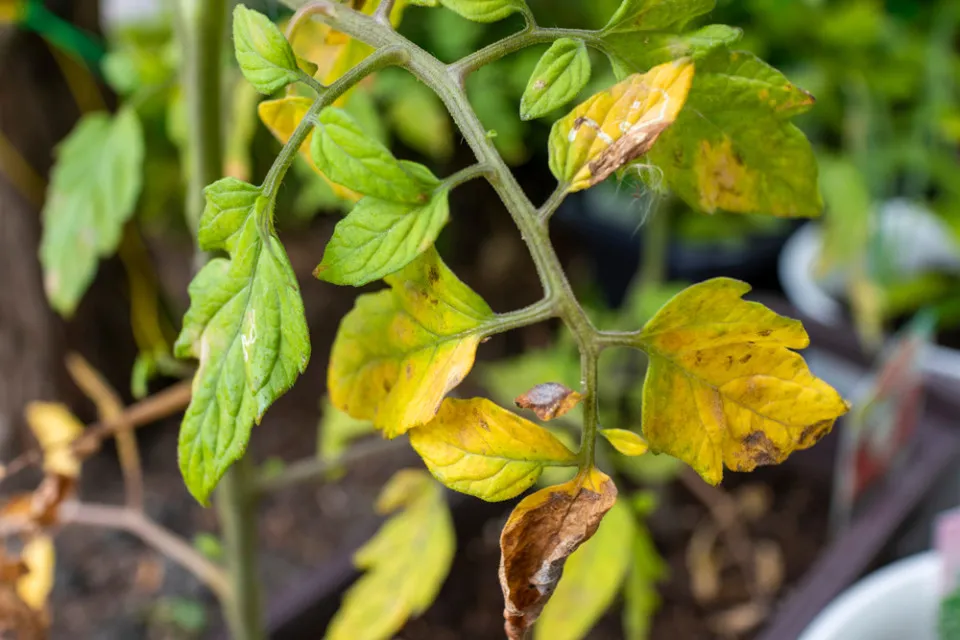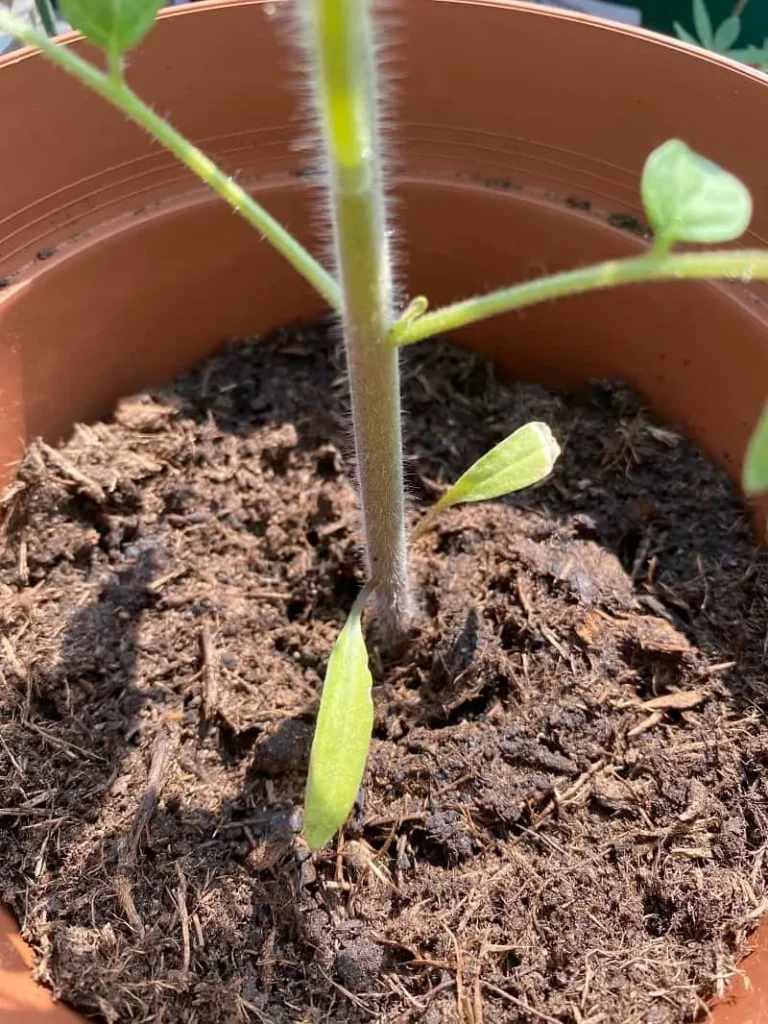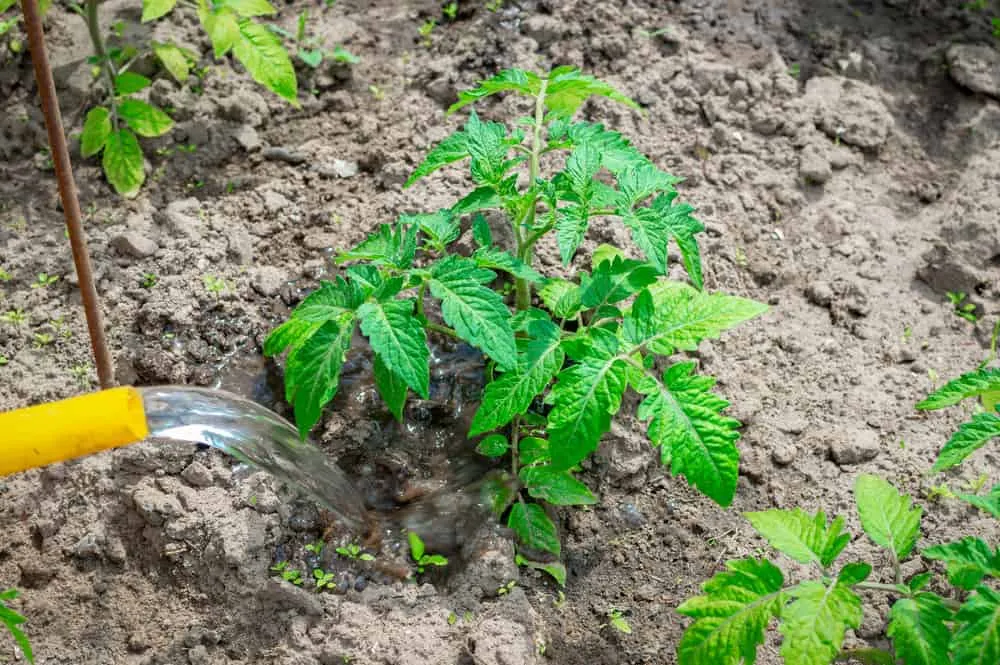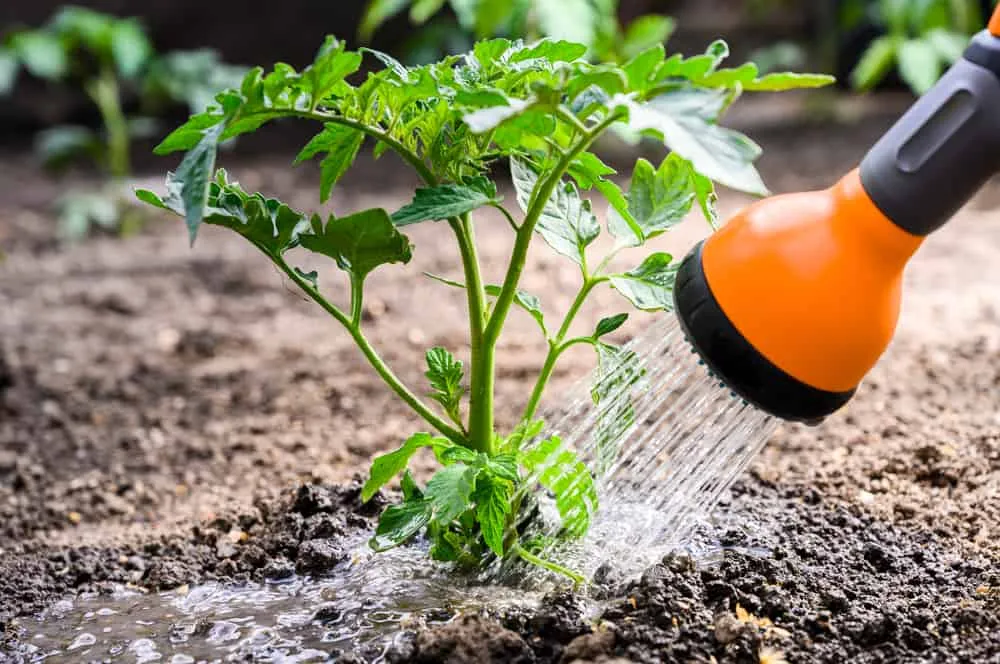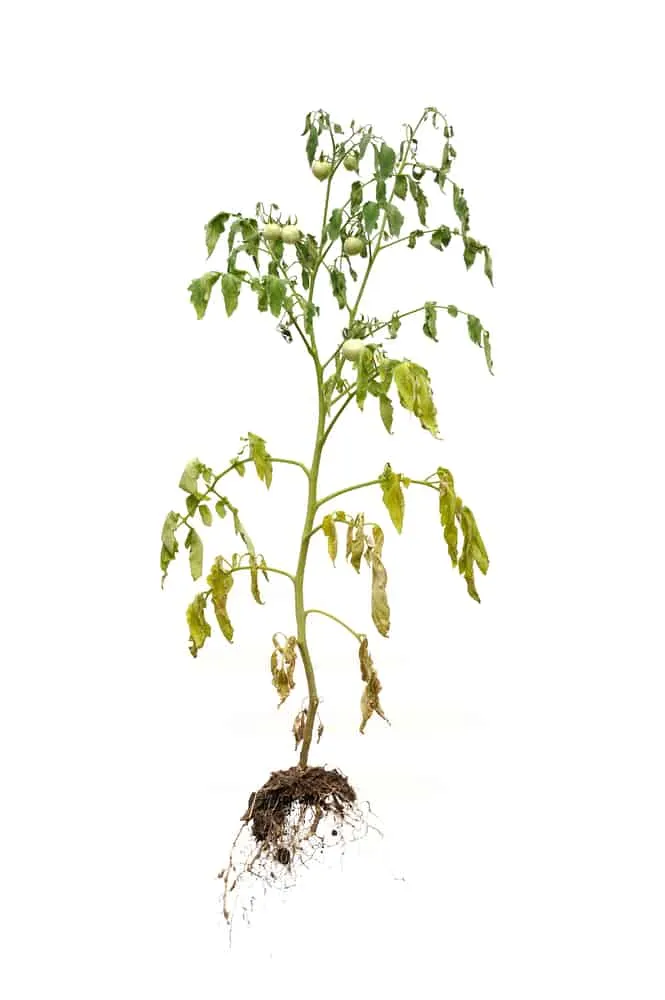Yellowing Tomato leaves tend to cause panic among tomato growers.
A once thriving plant transforming from green to yellow triggers alarm and prompts hasty solutions, which may do more damage than good.
However, yellow foliage on tomato vegetation is a highly prevalent issue that countless tomato cultivators encounter at some point during the maturation phase.
In most cases, the dilemma is easily rectified (like improper irrigation) or maybe not even a cause for concern.
These seven complications are the most frequent explanations for tomato leaves changing colour to yellow.
Recognize the problem (if one exists), implement the resolution, and your crops will rapidly return to normal.
1. The Cotyledons Are Transforming Yellow
Let’s address this first since it’s one of the most prevalent concerns for novice tomato farmers and is not concerning.
If the leaves below are changing colour to yellow on your young tomato vegetation or seedlings, do not fret. These are the cotyledons, also referred to as seed leaves. They are the initial leaves to develop when the seeds sprout but are not “true” leaves.
It is part of the maturation process that these leaves transform yellow and drop off, and it is nothing to worry about.
2. Watering Problems
The Cause
The most likely reason for yellow leaves on tomato flora is improper irrigation. Watering is a technique many cultivators get incorrect – occasionally by supplying the vegetation with too little water, but frequently by providing too much.
In our attempts to satisfy the plants, farmers may overdo it on the care front and provide the flora far more water than it genuinely necessitates in fear that the soil will dry out.
The surplus water in the soil can suffocate the roots and prompt them to decay. As the roots are impaired and there is less oxygen in the soil, there is less oxygen accessible to the leaves, causing them to transform yellow and fall off.
Underwatering can also result in the leaves becoming yellow after wilting. If under-watering is the dilemma, the leaves will start to yellow from the edges until the entire leaf drops off the plant.
The Fix
By evaluating your watering habits, you will likely ascertain if irrigation is the perpetrator. If you have watered when the top layer of soil is still damp or if the soil has become waterlogged, overwatering is likely the cause.
Under-watering is your culprit if the leaves are wilting and the plant struggles to stand upright (or if you know you’ve missed a watering session or two).
Proper watering is vital to the health of your tomato flora. Inspect the soil daily and only hydrate when the plant necessitates it – approximately when the top 1 or 2 inches of soil has dried out.
Water in the mornings to prevent any evaporation or damage to the leaves. Apply water to the soil surrounding the roots, not the leaves, and rinse slowly and deeply to saturate the soil and encourage deep root development completely.
If overwatering is the cause and the problem does not fix itself, you may be dealing with a bad case of root rot.
Unfortunately, it is very difficult to save plants at this stage. You can dig up the plant, remove the decayed sections of roots, and plant in brand-new soil. However, it may be best to start from scratch depending on how many roots are left and the plant’s growth.
3. Soil Compression
The Cause
A similar issue occurs when the soil surrounding your tomato flora has insufficient aeration. The roots do not have access to adequate oxygen and begin to suffocate.
The roots cannot transport oxygen, water, and other nutrients throughout the plant. This prompts the leaves to turn yellow and indicates that the plant is on its way out.
The Fix
Depending on the roots’ establishment, you can aerate the soil by loosening it with your hands. However, this will likely impair the root system and cause more problems. To avoid this dilemma, starting the plant in good soil enriched with organic matter is best.
Soil compaction is often triggered by walking on the soil, so cultivating tomatoes in raised beds or large pots is one technique to solve the issue.
4. Transplant Shock
The Cause
If you’ve recently transplanted your seedlings (around a week or two before) and notice yellowing leaves on the bottom of the plant, transplant shock is likely the reason.
When seedlings are relocated from a warm area – indoors or a greenhouse – to cold soil outdoors, they require time to adapt to their new conditions.
The shock can prompt the bottom few leaves of the plant to become yellow.
Thankfully, this is just a short phase of adjustment. As long as the new growth is green and healthy, there is no cause for concern. The yellow leaves will eventually drop off, and the plant will return to good health.
The Fix
As transplant shock is not usually harmful to the plant and is not fixable once detected, it’s best to prevent the issue instead. Before transplanting, guarantee the soil has warmed and that night temperatures don’t drop too low (below 50F).
If you uncover signs of transplant shock, you can help the plant’s recovery by removing the yellowing leaves at the stem. This will guide the energy toward the much-needed new growth and away from trying to sustain dying leaves.
5. Diseases
The Cause
One of the more deceitful causes of yellowing leaves is illness. Several tomato plant diseases prompt yellow leaves, which are problematic to tackle once established.
The first offender is early blight, caused by a fungus in the soil. Luckily, this issue is simple to identify. A pale yellow area will materialize in the lower leaves, transforming into a dark brown patch with yellow at the edges. If left untreated, the entire leaf will become yellow and drop off.
Similar markings appear due to another fungal disease, Septoria leaf spot. Tomato plants affected by this fungus will display large brown spots in their leaves, connected by patches of yellow.
Untreated, the problem can move from the leaves to the plant’s stem and cause even more damage.
Then there are the various ‘wilts’ – Fusarium wilt, Verticillium wilt, and Bacterial wilt.
Fusarium wilt originates in the soil and infects the plant’s roots, hindering water transportation to the stems and leaves of the vegetation. The plant will seem wilted, even though there is adequate water in the soil, and the leaves will begin to fall off the plant from the bottom up.
Indications of Verticillium wilt are akin to early blight and Septoria leaf spot. On the lower leaves, pale yellow areas form, encompassed by brown veins. Eventually, These spots will brown, and the leaves will detach from the plant.
Less prevalent is Bacterial wilt, prompted by a bacterium commonly discovered in sandy soils when they are damp. This illness typically starts upon transplanting but doesn’t exhibit signs until later into the season. The leaves transform yellow abruptly, and the plant will begin to wilt.
The Fix
Any indications of illness in your tomato plants necessitate immediate action. If left untreated, the issue can propagate to the rest of your plant and other garden areas.
Early blight and Septoria leaf spot can be regulated if detected early. Eliminate and discard the impacted leaves, keeping them away from other vegetation in your garden. Administer a fungicide intended to treat the problem, pursuing the instructions on the product precisely until the issue improves.
Unfortunately, if you come across any of the three ‘wilts’, you must discard the plant promptly. There is no cure for these diseases; they will circulate in your garden if they can. When removing the affected plant, guarantee it does not make contact with any other plants to avoid spread.
While there is no sure technique to prevent issues with diseases, there are actions you can take to restrict your risk.
Opt for varieties with excellent resistance to these illnesses and allow each plant adequate space so the leaves do not touch. Clean your gardening tools regularly and practice crop rotation for good soil health.
6. Nutrient Deficiency
The Cause
You may have a nutrient deficiency if none of the preceding dilemmas clarifies your yellowing leaves. This could either be the consequence of a shortage of a particular macronutrient or micronutrient in the soil or a complication with the plant’s capacity to absorb that nutrient.
The principal macronutrient offender of yellowing leaves is nitrogen.
Nitrogen is imperative for a plant’s healthy maturation and leaf production. The older leaves will turn pale yellow when the plant does not obtain adequate nitrogen. If you notice the plant halts growing after this period, lack of nitrogen is your answer.
A shortage of certain micronutrients can also prompt the leaves to yellow due to chlorosis. When the tomato plant lacks access to micronutrients essential to photosynthesis – magnesium, iron, sulfur, or zinc – it cannot generate chlorophyll. This causes the leaves to become yellow while the veins remain bright green.
The Fix
If you suspect nutrient deficiency is the issue, administer a general fertilizer. Most all-purpose fertilizers will have an equilibrium of nutrients to counterbalance any deficiency in the soil.
To be sure, it is optimal to conduct a soil test. This will confirm the origin of the problem and enable you to fix it with a targeted resolution.
For instance, magnesium deficiency can be combated by applying an Epsom salt mixture to the leaves. Without a soil test, you cannot be positive for a deficiency and may end up impairing the plant further by applying fixes that are not necessary.
A soil test will also confirm whether the soil or the plant is the problem.
Remember, a complication with the soil does not always prompt nutrient deficiency in a plant. There may be a problem with the plant’s roots that cannot transport nutrients throughout the plant, rather than an issue with the soil specifically.
If the soil test confirms no deficiency in the soil, analyze your watering habits and the aeration in the soil to resolve the problem.
7. It’s The End Of The Season
Examine the time of year before running through these circumstances and administering a million fixes.
Is the tomato season concluding? If so, yellowing leaves are no cause for alarm. Instead, they are a part of the plant’s natural lifecycle, signaling production is approaching an end.
Once the leaves start to drop off, you can trim any new growth and dying leaves to encourage the ripening of the final fruits on the plant.
The first decree of any gardening fix is – don’t panic.
Based on the signs stated here, your analysis of the plant, and your care routine, you will likely know which dilemma is the most probable.
When fixing issues with yellowing leaves, always take it slow to provide the plant time to adapt before you transition to another fix. Unless the problem is disease-related, you’ll need to act promptly (fortunately, diseases are generally more straightforward to identify).
It is a game of trial and error. If one fix doesn’t work, gradually move on to another until the plant returns to normal. In no time, you’ll have the diagnosis skills of a victorious plant doctor and can quickly fix tomato plant problems.

